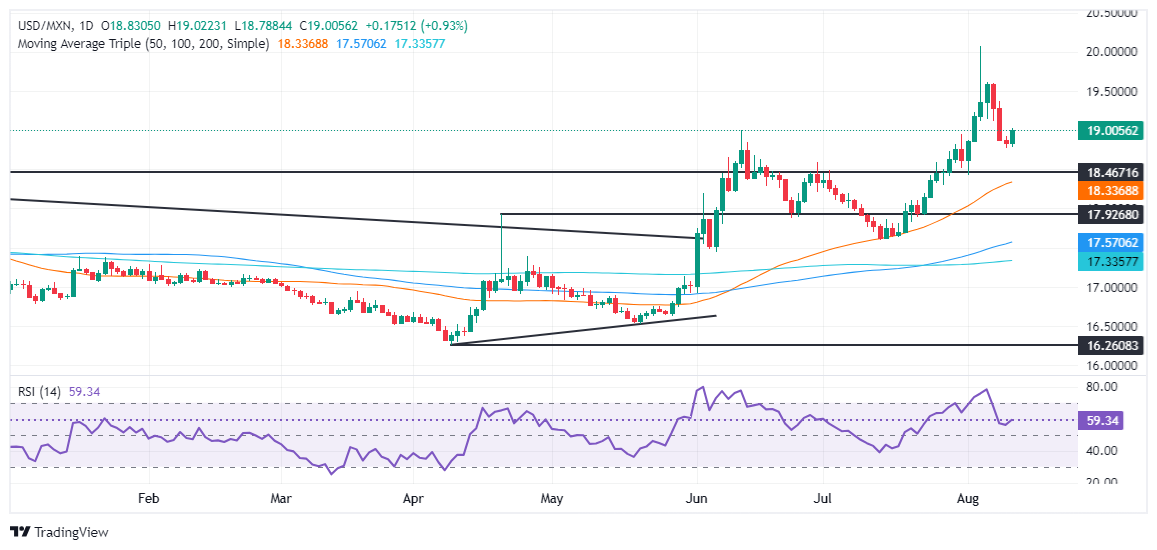Mexican Peso plunges following remarks by Banxico’s Rodriguez

- Mexican Peso pulls back after gaining over 1.50% last week, pressured by weaker Consumer Confidence.
- Banxico Governor Rodriguez justifies recent 25 bps rate cut amid 3-2 split decision, citing transitory inflation effects.
- Market focus shifts to key US inflation and retail sales data, USD gains momentum ahead of the releases.
The Mexican Peso retreats on Monday after posting solid gains of over 1.50% last week against the Greenback, with the latter posting decent gains ahead of a busy economic docket in the United States. Meanwhile, Consumer Confidence in Mexico dipped in July, which could be a prelude to the ongoing economic slowdown. The USD/MXN trades at 19-05 and gains over 1%.
Mexico’s National Statistics Agency announced that consumers grew less optimistic about the economic outlook and printed the second lowest reading since May’s 46.8 reading, revealed the Instituto Nacional de Estadistica Geografia e Informatica (INEGI).
In addition, Bank of Mexico (Banxico) Governor Victoria Rodriguez Ceja said in an interview with El Financiero that elements justified a 25-basis-point (bps) rate cut to the main reference rate amid a 3-2 split decision.
She acknowledged that despite headline inflation hitting 5.57%, she insisted it was unrelated to core prices, which decreased for the 18-straight month and reached 4.05% in July.
“We expect these effects of the shocks that we observe in non-core inflation to be transitory, so we are still expecting headline inflation to return to its target at the same time, at the end of 2025,” Rodriguez noted.
The USD/MXN depreciated following Banxico’s decision. Yet traders are laser-focused on the release of US inflation figures on Tuesday and Wednesday, followed by Retail Sales data on Thursday and Friday’s University of Michigan (UoM) Consumer Sentiment.
Daily digest market movers: Mexican Peso is heavy following Banxico’s cut
- Banxico’s board revealed that the Consumer Price Index (CPI) is expected to rise to 5.2% in Q3 and to edge lower to 4.4% in Q4, both readings for the remainder of 2024. They expect it will reach the 3% plus or minus 1% goal by Q4 2025.
- The board updated its inflation forecasts, indicating that headline inflation is expected to rise in the short term but remain unchanged in the longer term. Core inflation is projected to edge lower and dip below 4% in the fourth quarter of 2024.
- Mexico’s central bank acknowledged that inflationary risks remain tilted to the upside, while growth is biased to the downside.
- The CME FedWatch Tool shows the odds of a 50-basis-point interest rate cut by the Fed at the September meeting at 47.5%, down from 52.5% last Friday.
Technical analysis: Mexican Peso depreciates as USD/MXN rallies above 18.90
The USD/MXN uptrend resumed on Monday after hitting a six-day low of 18.76, yet traders had lifted the exchange rate past 18.90 with buyers eyeing a test of the psychological 19.00 figure.
The Relative Strength Index (RSI) is above the 50-neutral line, hinting that momentum favors buyers, which could push the exchange rate upward.
If USD/MXN clears 19.00, the next resistance would be 19.50, followed by the key 20.00 mark. A decisive break will expose the YTD high at 20.22, followed by the 20.50 mark.
Conversely, and in the most unlikely scenario in the short term, the USD/MXN’s first support would be the August 9 low 18.76. If surpassed, the next demand zone would be the June 28 peak at 18.59, followed by the psychological 18.50 mark.
Banxico FAQs
The Bank of Mexico, also known as Banxico, is the country’s central bank. Its mission is to preserve the value of Mexico’s currency, the Mexican Peso (MXN), and to set the monetary policy. To this end, its main objective is to maintain low and stable inflation within target levels – at or close to its target of 3%, the midpoint in a tolerance band of between 2% and 4%.
The main tool of the Banxico to guide monetary policy is by setting interest rates. When inflation is above target, the bank will attempt to tame it by raising rates, making it more expensive for households and businesses to borrow money and thus cooling the economy. Higher interest rates are generally positive for the Mexican Peso (MXN) as they lead to higher yields, making the country a more attractive place for investors. On the contrary, lower interest rates tend to weaken MXN. The rate differential with the USD, or how the Banxico is expected to set interest rates compared with the US Federal Reserve (Fed), is a key factor.
Banxico meets eight times a year, and its monetary policy is greatly influenced by decisions of the US Federal Reserve (Fed). Therefore, the central bank’s decision-making committee usually gathers a week after the Fed. In doing so, Banxico reacts and sometimes anticipates monetary policy measures set by the Federal Reserve. For example, after the Covid-19 pandemic, before the Fed raised rates, Banxico did it first in an attempt to diminish the chances of a substantial depreciation of the Mexican Peso (MXN) and to prevent capital outflows that could destabilize the country.
